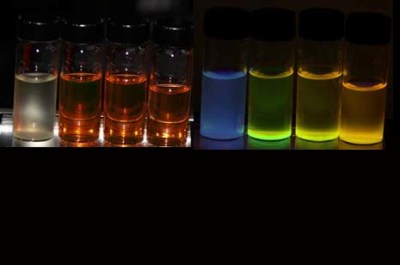A three-year grant worth just over $1 million will be shared by the scientists at the Arkansas State University and University of Arkansas to conduct research on the use of semiconductor and metallic nanoparticles in the production of solar cells that are used as power source in satellites and spacecrafts.
Omar Manasreh, principal investigator and electrical engineering professor at the University of Arkansas, will secure $710,646, which includes cost-sharing funds of $236,882 from the University of Arkansas and $473,764 from NASA. Liangmin Zhang, who serves as an Assistant Professor at Arkansas State University, will secure $85,617 from Arkansas State University and $171,235 from NASA. In 2010, the U.S. Air Force Office of Scientific Research awarded a five-year grant worth $1.13 million, which comprised the University of Arkansas’ cost sharing funds, to Manasreh for similar type of work.
 When ultraviolet light is applied to nanocrystals in the vials on the left, the size of the nanocrystals change and emit different, more colorful light. These nanocrystals are investigated for their use in high performance solar cells.
When ultraviolet light is applied to nanocrystals in the vials on the left, the size of the nanocrystals change and emit different, more colorful light. These nanocrystals are investigated for their use in high performance solar cells.
The research on the development of semiconductor and metallic nanoparticles at the Optoelectronics Research Lab of Manasreh could ultimately pave the way to the inception of a private firm in Arkansas. The major objective of the work is to produce and demonstrate a solar cell that can have a conversion efficiency of 40% or more. The conversion efficiency of silicon technology-based solar panels currently employed on NASA spacecrafts and satellites is exceeding 23%.
Manasreh uses two methods to produce solar cells. In the first method, a combination of copper, indium, gallium and selenium (CuInGaSe2 and CuInSe2) is utilized as the semiconductor material in place of silicon to grow nanocrystals. The researchers craft the nanocrystals functional by producing volatile ligands, molecules that attach to a central atom. The functionalized nanocrystals are then either coupled with zinc oxide or titanium dioxide nanotubes or modified into thin films to fabricate the required solar cells, which was then subsequently tested and assessed for their performance by the researchers.
The second method employs the molecular beam epitaxy, a process of nanocrystal deposition, to fabricate quantum dots made of indium arsenide (InAs). Quantum dots are nanoscale semiconductor material. In order to improve the solar cell performance, short ligands will be used by the researchers to combine metallic nanoparticles to the quantum dots and nanocrystals. The researchers will then study trapping the sun light’s plasmonic effect, which in turn augments the conversion efficiency of the cells. A plasmon is the quantum of charge waves produced by light.